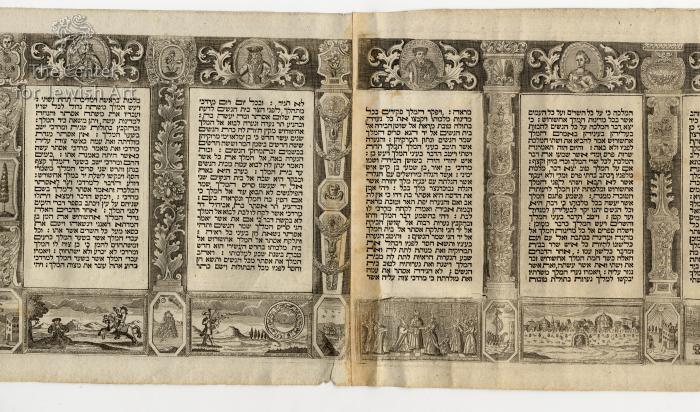
Acanthus Leaf
Columns
Vase
Landscape
Architectonic motif
Floral motif
Bust (Human figure)
Garland
Flower
Angel's head
Mordecai at the king's gate (Es. 2:19 and/or 2:21)
Ahasuerus' and Esther's wedding
Haman casting the lot/Pur - Haman aiming at the Zodiac wheel (based on Midrash)
Zodiac Signs
Messenger(s) delivering the decree of Haman (Es. 3:13)
Mordecai in mourning (Es. 4:1)
Haman paying money to the king (Es. 3:9)
Haman entreats Ahasuerus to issue a decree destroying the Jews (Es. 3:9)
Esther's first banquet (Es. 5:5-8) |
Text column no. 3 (sheet no. 1): In the upper margin, a bust of a young woman (Esther?) is depicted. The frame in the lower margins contains the depiction of the walled city. In the central part of the wall, there is a gate at which a man (Mordecai) is seated (Es. 2:19 and/or 2:21).
Text column no. 4 (sheet no. 1): In the upper margin, a bust of a bearded man with a flat cap on the head (Mordecai?) is depicted. In the frame in the lower margin, a wedding ceremony of Ahasuerus and Esther is represented. The scene is witnessed by a group of men standing on the left and a group of women standing on the right. The Book of Esther does not mention this episode and the source for this representation remains unknown. It can be influenced by European paintings in which the scene of the marriage of the Virgin Mary and Josef was similarly composed. This can also explain the dress of a man standing in the center that refers to the high priest's robes.
Text column no. 5 (sheet no. 2): In the upper margin, a bust of a man in a long curly wig and tricorn hat on it (one of the princes of Media and Persia listed in Es. 1:14?, one of the servants?) is depicted. In the frame placed in the lower margin, a man with a bow in his hands is depicted; he is aiming at the wheel with the signs of Zodiac on its perimeter. The scene is shown against the landscape. The depiction symbolically shows the moment of casting lots by Haman (alludes to Es. 3:7). The Book of Esther mentions only casting lots that means appointing the least favorable period for Jews, but there is no reference to the signs of the Zodiac in the text.
Text column no. 6 (sheet no. 2): In the upper margin, a bust of the king is depicted. In the frame placed in the lower margin, on the right, a mounted messenger is carrying the edict of Haman that he holds in his left hand (Es. 3:13) and in his other hand, he has a French horn. He is riding towards a man sitting under a tree (on the left), most likely Mordecai, who tears his clothes as a sign of mourning (Es. 4:1).
In the octagons separating the frames are depicted (from right to left): 1) a cityscape with a sun shining over a city, 2) a harbor with a ship, 3) a landscape with hills and a castle (?), 4) a castle (?) on a hill-island on the sea.



